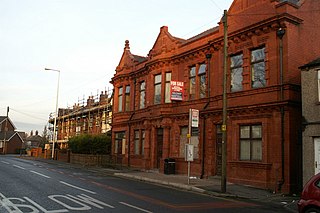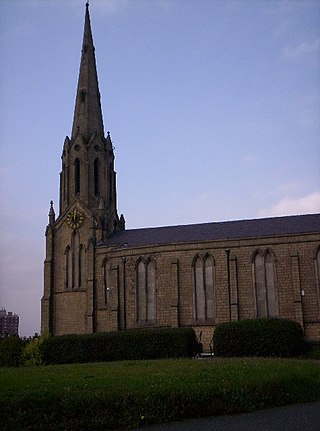Related Research Articles

In the United Kingdom, a listed building is a structure of particular architectural and/or historic interest deserving of special protection. Such buildings are placed on one of the four statutory lists maintained by Historic England in England, Historic Environment Scotland in Scotland, Cadw in Wales, and the Northern Ireland Environment Agency in Northern Ireland. The classification schemes differ between England and Wales, Scotland, and Northern Ireland. The term has also been used in the Republic of Ireland, where buildings are protected under the Planning and Development Act 2000, although the statutory term in Ireland is "protected structure."

Ashton-in-Makerfield is a market town in the Metropolitan Borough of Wigan, Greater Manchester, England, 4 miles (6.4 km) south of Wigan. As of the 2021 census, there was a population of 26,380.
There are over 2500 listed buildings in Liverpool, England. A listed building is one considered to be of special architectural, historical or cultural significance, which is protected from being demolished, extended or altered, unless special permission is granted by the relevant planning authorities.

Abram is a village and electoral ward in the Metropolitan Borough of Wigan, Greater Manchester, England. It lies on flat land on the northeast bank of the Leeds and Liverpool Canal, 2 miles (3.2 km) west of Leigh, 3 miles (4.8 km) southeast of Wigan, and 14.5 miles (23 km) west of Manchester. Abram is a dormitory village with a population of 9,855.
There are over 9,300 Grade I listed buildings in England. This page is a list of these buildings in the county of Isle of Wight.

Runcorn is an industrial town in the borough of Halton, Cheshire, England. This list contains the 27 buildings that are recorded in the National Heritage List for England as designated listed buildings in the part of the borough lying to the south of the River Mersey outside the urban area of Runcorn. The area covered includes the villages of Clifton, Daresbury, Preston Brook, Preston on the Hill, and Moore. Three of the buildings in the area are classified as Grade II*, and the others are at Grade II; there are no buildings in Grade I. In the United Kingdom, the term listed building refers to a building or other structure officially designated as being of special architectural, historical, or cultural significance. These buildings are in three grades: Grade I consists of buildings of outstanding architectural or historical interest; Grade II* includes particularly significant buildings of more than local interest; Grade II consists of buildings of special architectural or historical interest. Buildings in England are listed by the Secretary of State for Culture, Media and Sport on recommendations provided by English Heritage, which also determines the grading.

St Catharine's Church is in Lorne Street, Scholes, Wigan, Greater Manchester, England. It is an active Anglican parish church in the deanery of Wigan, the archdeaconry of Warrington and the diocese of Liverpool. Its benefice is united with that of Christ Church, Ince-in-Makerfield. The church is recorded in the National Heritage List for England as a designated Grade II listed building. It was a Commissioners' church, having received a grant towards its construction from the Church Building Commission.

Saint Edmund's Church is a redundant church building located on Clement Royds Street in the Falinge area of Rochdale, in Greater Manchester, England. Commissioned by Rochdale's local industrialist and Freemason Albert Royds, the construction of the building was completed to a high and rich specification in 1873, with an "enormous" cost of around £25,000. It is the only known church building in England so overtly dedicated to Masonic symbolism and is therefore unique within English architecture.

Christ Church is in Ince Green Lane, Lower Ince, Ince-in-Makerfield, Greater Manchester, England. It is an active Anglican parish church in the deanery of Wigan, the archdeaconry of Warrington, and the diocese of Liverpool. Its benefice is combined with that of St Catharine, Wigan. The church is recorded in the National Heritage List for England as a designated Grade II listed building.

St Michael and All Angels' Church is in Leigh Road, Howe Bridge, a suburb of Atherton, Greater Manchester, England. It is an active Anglican parish church in the deanery of Leigh, the archdeaconry of Salford and the diocese of Manchester. Its benefice is united with those of three local churches, St John the Baptist, St George and St Philip, forming a team ministry entitled the United Benefice of Atherton and Hindsford with Howe Bridge. The church is recorded in the National Heritage List for England as a designated Grade II* listed building.

Greater Manchester is a metropolitan county in North West England. It was created by the Local Government Act 1972, and consists of the metropolitan boroughs of Bolton, Bury, Oldham, Rochdale, Stockport, Tameside, Trafford, Wigan and the cities of Manchester and Salford. This is a complete list of the Grade I listed churches in the metropolitan county as recorded in the National Heritage List for England. Buildings are listed by the Secretary of State for Culture, Media and Sport on the recommendation of English Heritage. Grade I listed buildings are defined as being of "exceptional interest, sometimes considered to be internationally important"; only 2.5 per cent of listed buildings are included in this grade.

St Thomas' Church is in Warrington Road, Ashton-in-Makerfield, Greater Manchester, England. It is an active Anglican parish church in the deanery of Wigan, the archdeaconry of Warrington, and the diocese of Liverpool. Its benefice is united with that of St Luke, Stubshaw Cross. The church is recorded in the National Heritage List for England as a designated Grade II listed building.
There are many Grade II listed buildings in the city of Manchester, Greater Manchester, England. The majority of Manchester's listed buildings date from the Victorian (1837–1901) and Edwardian (1901–1911) eras, most as a consequence of the Industrial Revolution. In England and Wales, the authority for listing is granted by the Planning Act 1990 and is administered by English Heritage, an agency of the Department for Culture, Media and Sport. There are three categories of listing – Grade I, Grade II* and Grade II.
Ripley School Chapel is part of what is now the Ripley St Thomas Church of England Academy, located in Ashton Road, Lancaster, Lancashire, England. It is considered to be of architectural importance and is recorded in the National Heritage List for England as a designated Grade II* listed building.
Tyldesley is a town in the Metropolitan Borough of Wigan, in Greater Manchester, England. It contains several listed buildings designated by English Heritage and included in the National Heritage List for England. Most are listed at Grade II, the lowest of the three gradings given to listed buildings and is applied to "buildings of national importance and special interest".
Astley is a settlement in the Metropolitan Borough of Wigan in Greater Manchester, England. Originally a village, it now forms a continuous urban area with Tyldesley to the north. It lies on flat land north of Chat Moss and is crossed by the Bridgewater Canal and the A580 "East Lancashire Road". Astley contains several listed buildings designated by English Heritage and included in the National Heritage List for England. Most are listed at Grade II, the lowest of the three gradings given to listed buildings and is applied to "buildings of national importance and special interest".

There are 48 Grade I listed buildings in Greater Manchester, England. In the United Kingdom, the term listed building refers to a building or other structure officially designated as being of special architectural, historical or cultural significance; Grade I structures are those considered to be "buildings of exceptional interest". In England, the authority for listing under the Planning Act 1990 rests with Historic England, a non-departmental public body sponsored by the Department for Culture, Media and Sport.

Stoke-on-Trent is a city located in Staffordshire, England. The city is a linear conurbation of six constituent towns. Stoke-on-Trent is considered to be the home of the pottery industry in England and is commonly known as the Potteries. Formerly a primarily industrial conurbation, it is now a centre for service industries and distribution centres.
Ashton-in-Makerfield is a town in the Metropolitan Borough of Wigan, Greater Manchester, England. It contains ten listed buildings that are recorded in the National Heritage List for England. All the listed buildings are designated at Grade II, the lowest of the three grades, which is applied to "buildings of national importance and special interest". Industry, including coal mining, came to the town in the 19th century, but it is now mainly residential. The older listed buildings consist of farmhouses, a farm building, a chapel and a milestone, and the later ones are churches and associated structures, and a library.
Ince-in-Makerfield is a town in the Metropolitan Borough of Wigan, Greater Manchester, England. The town and the surrounding area contains eight listed buildings that are recorded in the National Heritage List for England. All the listed buildings are designated at Grade II, the lowest of the three grades, which is applied to "buildings of national importance and special interest".
References
- ↑ "Listed Buildings". historicengland.org.uk. Historic England . Retrieved 29 May 2017.